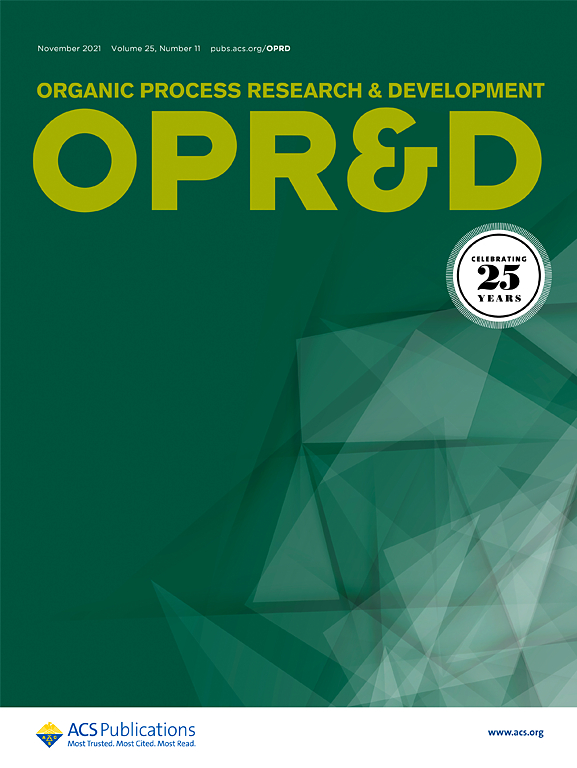IL-17A抑制剂LY3509754可扩展工艺的开发:第一部分:生物催化和CSTR技术催化合成吡嗪基咪唑烷酮中间体
IF 3.1
3区 化学
Q2 CHEMISTRY, APPLIED
引用次数: 0
摘要
介绍了合成咪唑基咪唑烷酮中间体用于咪唑[1,2-b]吡啶嘧啶IL-17A抑制剂的工艺开发和规模化。开发了一种用于制备(S)-3,3,3-三氟丙烷-1,2-二胺的转氨化工艺,消除了不稳定的烯胺中间体,该中间体严重限制了原始不对称加氢途径的可扩展性。在低温条件下,开发了一种CSTR连续流工艺用于N-(6-氯吡嗪-3-酰基)戊酰胺羰基化,成功抑制了产物分解,将分离收率从批处理工艺的约40%提高到约60%。建立了一个稳健的KRED工艺,将N-(6-氯-5-(2-甲氧基乙酰基)吡嗪-3-基)戊酰胺还原为相应的手性醇,并与(S)-3,3,3-三氟丙烷-1,2-二胺进行SN2反应衍生为其三氟化产物,并与羰基二咪唑反应组装目标吡嗪基咪唑烷酮中间体。开发的工艺成功地扩大了生产157公斤吡嗪基咪唑烷酮中间体的规模,以支持最终原料药的生产,证明了优化工艺的稳健性。本文章由计算机程序翻译,如有差异,请以英文原文为准。

Development of a Scalable Process for an IL-17A Inhibitor LY3509754: Part I: Synthesis of the Pyridazinyl Imidazolidinone Intermediate Enabled by Biocatalysis and CSTR Technologies
Process development and scale-up of the synthesis of a pyridazinyl imidazolidinone intermediate for the production of an imidazo[1,2-b]pyridazine IL-17A inhibitor are described. A transamination process was developed for the preparation of (S)-3,3,3-trifluoropropane-1,2-diamine, eliminating an unstable enamine intermediate that significantly limited the scalability of the original asymmetric hydrogenation route. A CSTR continuous flow process was developed for the carbonylation of N-(6-chloropyridazin-3-yl)pivalamide under cryogenic conditions that successfully suppressed product decomposition, improving the isolated yield to ∼60% from the ∼40% yield of the batch mode process. A robust KRED process was developed for the reduction of N-(6-chloro-5-(2-methoxyacetyl)pyridazin-3-yl)pivalamide to the corresponding chiral alcohol, which was further derivatized as its triflate for the SN2 reaction with (S)-3,3,3-trifluoropropane-1,2-diamine and treated with carbonyl diimidazole to assemble the target pyridazinyl imidazolidinone intermediate. The developed process was successfully scaled up to deliver 157 kg of the pyridazinyl imidazolidinone intermediate to support the production of the final drug substance, demonstrating the robustness of the optimized process.
求助全文
通过发布文献求助,成功后即可免费获取论文全文。
去求助
来源期刊
CiteScore
6.90
自引率
14.70%
发文量
251
审稿时长
2 months
期刊介绍:
The journal Organic Process Research & Development serves as a communication tool between industrial chemists and chemists working in universities and research institutes. As such, it reports original work from the broad field of industrial process chemistry but also presents academic results that are relevant, or potentially relevant, to industrial applications. Process chemistry is the science that enables the safe, environmentally benign and ultimately economical manufacturing of organic compounds that are required in larger amounts to help address the needs of society. Consequently, the Journal encompasses every aspect of organic chemistry, including all aspects of catalysis, synthetic methodology development and synthetic strategy exploration, but also includes aspects from analytical and solid-state chemistry and chemical engineering, such as work-up tools,process safety, or flow-chemistry. The goal of development and optimization of chemical reactions and processes is their transfer to a larger scale; original work describing such studies and the actual implementation on scale is highly relevant to the journal. However, studies on new developments from either industry, research institutes or academia that have not yet been demonstrated on scale, but where an industrial utility can be expected and where the study has addressed important prerequisites for a scale-up and has given confidence into the reliability and practicality of the chemistry, also serve the mission of OPR&D as a communication tool between the different contributors to the field.

 求助内容:
求助内容: 应助结果提醒方式:
应助结果提醒方式:


